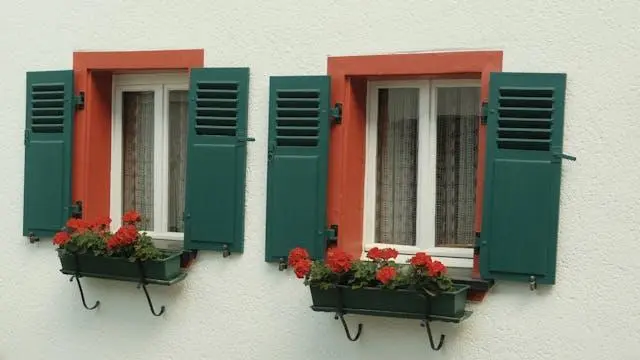Enhance Your Home’s Curb Appeal with Custom Flower Window Boxes

Imagine coming to your home, greeted by a burst of color and life that instantly lifts your spirits. That’s the magic of custom flower window boxes, a simple yet transformative way to elevate your home’s exterior.
Not only do these charming additions enhance the aesthetic appeal of your property with vibrant flowers and lush greenery, but they also potentially boost its market value. By personalizing your space with thoughtfully designed window boxes that reflect your style and complement your home’s architecture, you create an inviting atmosphere that catches the eye of passersby and prospective buyers alike.
Let’s dive into how custom flower window boxes can turn your home into the envy of the neighborhood.
People Also Read?
Choosing the Right Materials and Building Your Window Boxes
Selecting the right materials for your custom flower window boxes is the first step toward enhancing your home’s curb appeal. Durable materials like PVC and Cedar are top choices, each with its own set of benefits. PVC, known for its resilience to weathering and decay, offers a maintenance-free solution perfect for any climate. Conversely, Cedar boasts a natural resistance to rot and insects and a warm, woodsy aesthetic that ages beautifully over time, making it ideal for traditional and rustic home styles.
For those interested in exploring a variety of window box styles and materials, consider checking out flower window boxes for inspiration and purchase options.
Here’s a step-by-step guide to help you get started, as outlined by This Old House:
- Measuring the Window Sill: Accurately measure the length of your window sill to ensure the window box fits perfectly. Consider adding an extra inch or two for a slight overhang, which enhances visual appeal.
- Cutting the Materials: Cut the materials to the required lengths using a miter saw. Be precise with your measurements to ensure all pieces fit together seamlessly. You’ll need pieces for the box’s front, back, sides, and bottom.
- Assembling the Box: Attach the sides to the front and back panels. Use waterproof wood glue and screws for a secure assembly. Drilling pilot holes can help prevent the wood from splitting. Attach the bottom last, ensuring drainage holes allow excess water to escape.
Each step requires careful attention to detail, ensuring that the final product enhances your home’s exterior and withstands the elements, providing a lasting addition to your curb appeal. With the right tools and some elbow grease, your custom window boxes will be ready to fill with beautiful blooms and foliage.
People Also Read?
Designing Your Window Box Display

Once you’ve built your custom window boxes, the next exciting step is designing the display that best captures your home’s essence and style. Whether you aim for a look that changes with the seasons or a unique thematic design, your window boxes can be a canvas for creativity.
Seasonal Themes:
Adapting your window box to the changing seasons keeps your home looking fresh and timely all year round. For spring, consider planting a vibrant mix of tulips, daffodils, and pansies, which offer a lively burst of color. When autumn rolls around, transition to chrysanthemums and ornamental kale, which reflect the warm, rich tones of the season. Window Digest suggests incorporating seasonal accessories like miniature pumpkins in fall or evergreen sprigs and festive ornaments during the winter months to enhance the theme.
Specific Styles:
For a more permanent display, choose a style that resonates with your home’s aesthetic or personal preference. A Zen garden window box might feature succulents, smooth stones, and sparse, elegant arrangements, perfect for a minimalist approach. Alternatively, a fairy garden offers a whimsical escape with small flowering plants, tiny figurines, and colorful accessories that create a playful garden narrative.
Plant Selection Tips:
Choosing the right plants is crucial for maintaining the health and beauty of your window box. MyDomaine recommends selecting plants based on the amount of sunlight your window receives. Sun-loving plants such as petunias and marigolds are great for sunny sills, while impatiens and ferns might be better suited for shaded areas. Additionally, consider the color scheme of your home’s exterior when selecting flowers; aim for colors that complement or thoughtfully contrast your home to create a cohesive look.
By carefully planning your design and plant selection, your window boxes will enhance your home’s curb appeal and reflect your personal style and creativity, making your home stand out beautifully in any neighborhood.
Installation Tips
Proper installation of your custom window boxes is critical for aesthetics, safety, and longevity. Ensuring your window boxes are securely mounted can prevent accidents and maintain the structural integrity of the box and your home’s exterior.
Mounting for Safety and Stability:
The first step is locating the studs in your home’s exterior wall, providing the most secure anchor points for your window boxes. As This Old House recommends, use a stud finder to locate these supports accurately. Once you’ve determined the best placement, choose the right fasteners—stainless steel screws or bolts are ideal for their strength and resistance to rust. Be sure the screws are long enough to penetrate deep into the studs, creating a firm hold. It’s also wise to use a level during installation to ensure your window boxes are perfectly horizontal.
Ensuring Good Drainage and Avoiding Water Damage:
Good drainage is essential for the health of your plants and the longevity of your window boxes. Inadequate drainage can lead to waterlogged soil, which can cause root rot and other plant diseases. Drill holes in the bottom of your window box to promote proper drainage if they are not already present. This Old House advises placing a layer of gravel or small stones at the bottom of the box before adding soil, which helps to keep the drainage holes from becoming clogged. Additionally, consider the installation of spacers behind the window box, creating a small gap between the box and your home’s siding. This space allows air to circulate and prevents water from building up, which protects your home’s exterior from moisture damage.
By following these installation tips, your window boxes will be both a safe and functional addition to your home, enhancing its beauty and ensuring the health of your plants.
Maintenance and Seasonal Updates

Regular maintenance help your plants stay healthy and keep your window boxes looking their best.
Regular Maintenance Tasks:
- Watering: Ensure your plants receive the right amount of water, which can vary depending on the type of plants and the weather conditions. Check the soil moisture frequently—water when the top inch of soil feels dry. Consider using a watering can with a long spout to target the soil directly without soaking the foliage, which can help prevent disease.
- Fertilizing: Feed your plants a balanced, slow-release fertilizer to promote healthy growth and vibrant blooms. Apply according to the package directions, typically once at the beginning of the growing season and again mid-season for the best results.
- Deadheading: Regularly remove spent flowers to encourage new growth and prolong blooming periods. This keeps your plants looking neat and diverts energy back to the plant for more flowers and foliage.
Seasonal Plant Rotation:
Rotating your plants with the seasons refreshes the look of your window boxes and ensures that the plants are suited to the current weather conditions, which can greatly affect their health and beauty. Window Digest suggests incorporating plants that peak at different times of the year. For example, swap out summer blooms for chrysanthemums and ornamental kale in the fall. When winter approaches, transition to cold-hardy plants like evergreens or pansies, which can withstand lower temperatures.
Enhancing Appeal with Additional Features
To make your window boxes stand out, consider accessorizing with unique features that add function and flair. Decorative brackets can serve dual purposes—supporting and adding a stylistic touch. Opt for designs that complement the architecture of your home or add a whimsical element with ornate patterns.
For material choices, think beyond traditional wood or metal. Window Digest suggests using repurposed items like old wine crates or galvanized steel for a rustic or industrial look. Adding low-voltage lighting to your window boxes can extend their beauty into the evening, creating a warm, welcoming glow that enhances your home’s ambiance after dark. Additionally, decorative pebbles or colored mulch can be used to cover the soil, adding color and texture while helping retain the plants’ moisture.
Conclusion
Investing in custom flower window boxes is more than just a home improvement project; it’s an opportunity to enhance your home’s curb appeal and reflect your style. These boxes beautify your living space and potentially increase your property’s value. So why not take this chance to express your creativity and make your home stand out? With the rightmaterials, designs, and care, your window boxes will transform your home’s exterior into a vibrant display of life and color.



